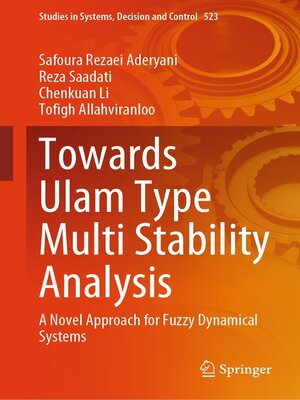Towards Ulam Type Multi Stability Analysis
ebook ∣ A Novel Approach for Fuzzy Dynamical Systems · Studies in Systems, Decision and Control
By Safoura Rezaei Aderyani

Sign up to save your library
With an OverDrive account, you can save your favorite libraries for at-a-glance information about availability. Find out more about OverDrive accounts.
Find this title in Libby, the library reading app by OverDrive.



Search for a digital library with this title
Title found at these libraries:
| Loading... |
The main target of this book is to present a new concept of Ulam-type stability, i.e., multi-stability, through the classical, well-known special functions and to obtain the best approximation error estimates by a different concept of perturbation stability including fuzzy approaches for uncertainty considerations. This stability allows us to obtain diverse approximations depending on various special functions that are initially chosen and to evaluate maximal stability and minimal error which enable us to obtain a unique optimal solution of functional equations, inequalities, and fractional equations. Stability analysis in the sense of the Ulam and its different kinds has received considerable attention from the researchers. However, how to effectively generalize the Ulam stability problems and to evaluate optimized controllability and stability are new issues. The multi-stability not only covers the previous concepts but also considers the optimization of the problem and provides a comprehensive discussion of optimizing the different types of the Ulam stabilities of mathematical models used in the natural sciences and engineering disciplines with fuzzy attitudes. Besides, this book also deals with nonlinear differential equations with various boundary conditions or initial value problems, based on the matrix Mittag-Leffler function, fixed point theory, as well as Babenko's approach to study uniqueness and existence of solutions. In general, the benefits for the readers can be concluded as follows:
1. Evaluates maximal stability with minimal error to get a unique optimal solution.
2. Discusses an optimal method of the alternative to study existence, uniqueness, and different types of Ulam stabilities under special consideration of the fuzzy approaches.
3. Delves into the new study of boundary value problems of fractional integro-differential equations with integral boundary conditions and variable coefficients.
1. Evaluates maximal stability with minimal error to get a unique optimal solution.
2. Discusses an optimal method of the alternative to study existence, uniqueness, and different types of Ulam stabilities under special consideration of the fuzzy approaches.
3. Delves into the new study of boundary value problems of fractional integro-differential equations with integral boundary conditions and variable coefficients.






